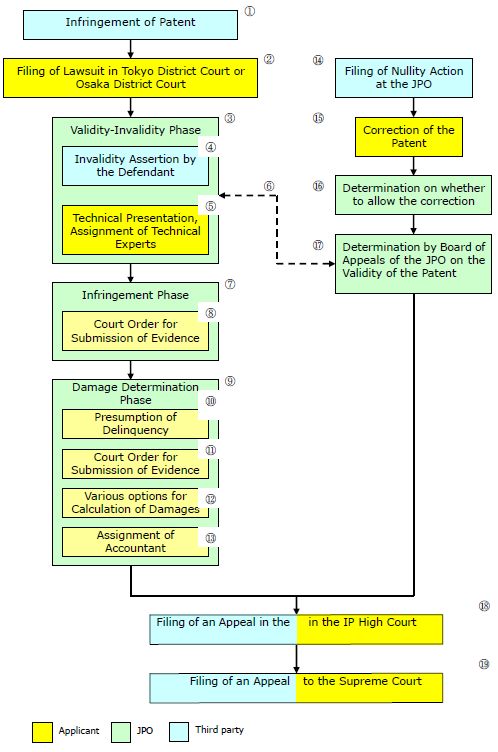
1. Infringement includes both direct and indirect infringement. Making and selling an object constitutes infringement if the use of the object infringes a patent and the use which infringes the patent is the only practical way of using the article that has been made or sold. Making and selling an article despite knowing that there is a patent, the article is an essential portion of the patent, and the article will be used in the infringement also constitute Indirect Infringement.
2. There are only two district courts, the Tokyo District Court and the Osaka District Court, that are empowered to judge patent infringement lawsuits.
3. The defendant is allowed to challenge the validity of the patent at issue at the infringement court. If the validity of the patent is challenged, the court hears the validity arguments before infringement and damage arguments. The defendant can also file a Nullity Action at the JPO (double track).
4. The Patent Law provides that the patentee does not have the right to enforce a patent when there is a reason to believe that the patent shall be invalidated if a Nullity Action is filed at the JPO.
5. Whenever necessary for the court, both parties may be requested to make technical presentations and outside technical experts may be assigned to facilitate the understanding of the judges. The parties are provided with the right to express opinions on the assignment of technical experts by the court.
6. The JPO and the infringement court have the discretion to suspend a trial until a judgment is made by the other, if necessary. In reality, the JPO and the district court exchange information so as to avoid split decisions. While the decision about the validity of the patent by the district court is binding only to the court, the decision about the validity by the JPO binds the courts once the decision becomes final.
7. The trial proceeds to the infringement phase only when the patent is held to be valid at the validity-invalidity phase. Since there is no discovery under Japanese law, the burden of collecting the evidence necessary to prove infringement by the defendant fundamentally rests with the patentee.
8. Once the court is convinced about the strong likelihood of infringement, the court can order the alleged infringer to submit evidence if any to prove non-infringement. The court may inspect the evidence in an in-camera proceeding without the patentee present. The court may, at its discretion, allow the patentee to see the evidence in order to decide whether the defendant has a good reason to refuse the submission of evidence.
9. If the patent is held valid and infringement is found, then the trial proceeds to the damage determination phase. It should be noted that two different prescription periods apply to the damage compensation and return of unjust enrichment. Concerning damage compensation, the patentee loses the right to demand damage compensation if he fails to file a patent infringement lawsuit within 3 years from the time the patentee discovered the fact of infringement and the infringer. The patentee is always entitled to demand damages which occurred in the last three years. With regard to the right to demand return of undue enrichment from the infringer, the patentee loses the right if no lawsuit is filed within 10 years from the start of the undue enrichment.
10. If infringement is found, an error is presumed by the alleged infringer in the absence of counter-evidence, providing the patentee with a legal basis to demand damage compensation. Disproving an error in infringement is difficult for the alleged infringer.
11. The court has the discretion to order the infringer to submit evidence so as to determine the damages caused to the patentee.
12. There are several ways of calculating the damages: 1) Number of infringing products sold by the infringer multiplied by the profit the patentee can expect from one product; 2) profit made by the infringer by the infringement; 3) and the royalties which are to be demanded for two similar patents. Damages equal to royalties or higher are guaranteed.
13. In the evaluation of damages, the court may assign an accountant and the parties are required to make any necessary explanations to the accountant.
14. It is common practice of defendants to file a Nullity Action at the JPO in addition to the arguments made for invalidity of the patent at the infringement court.
15. In response to the filing of a Nullity Action filed by the alleged infringer, the patentee may file a Trial for Correction of the patent to narrow the claims or cancel one or more claims.
16. Whether to allow the requested correction is examined before the validity of the patent. The correction is rejected if it broadens or shifts the claim scope. The correction is also rejected if the invention after the correction is not patentable.
17. Only the JPO is empowered to cancel claims or deregister a patent. A judgment by the courts that the patent shall be invalidated does not by itself cancels claims or deregister a patent.
18. A decision by the infringement court and a decision by the JPO can be appealed to the IP High Court. The two appeals are usually not combined because the timing and the parties are different.
19. The parties may file an appeal to the Supreme Court of Japan if they are dissatisfied by the outcome. The Supreme Court hears only a few IP related cases per year.
The content of this article is intended to provide a general guide to the subject matter. Specialist advice should be sought about your specific circumstances.
